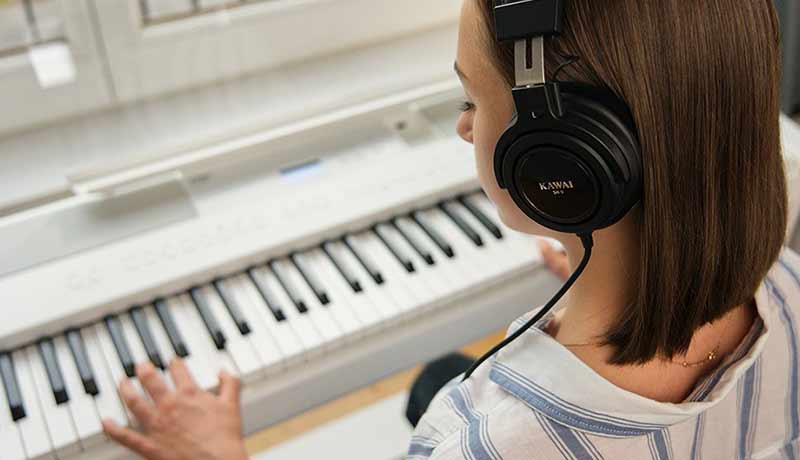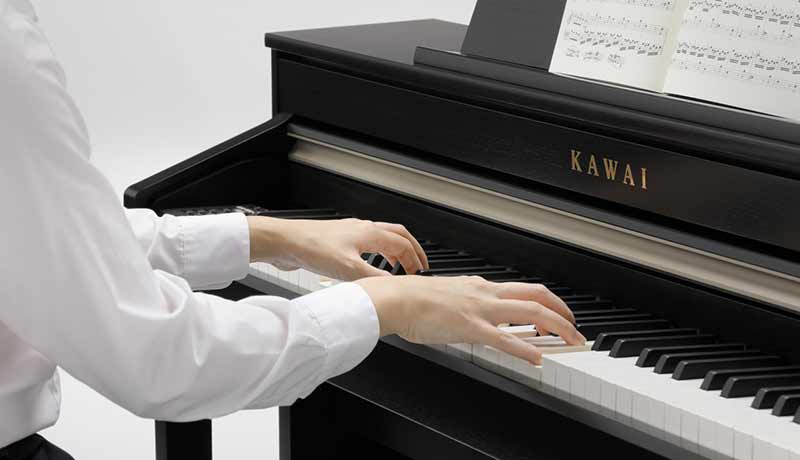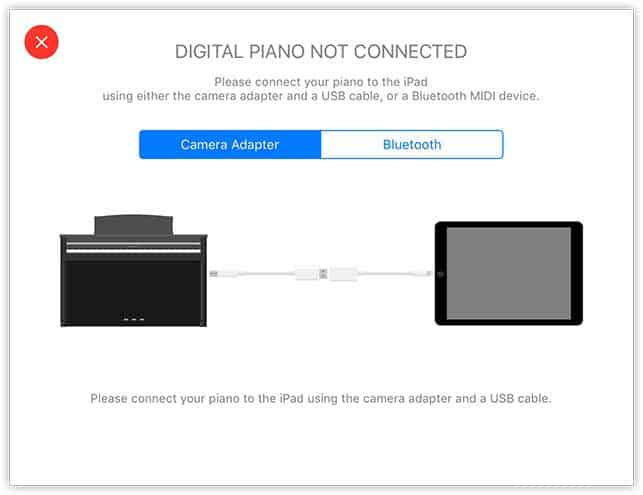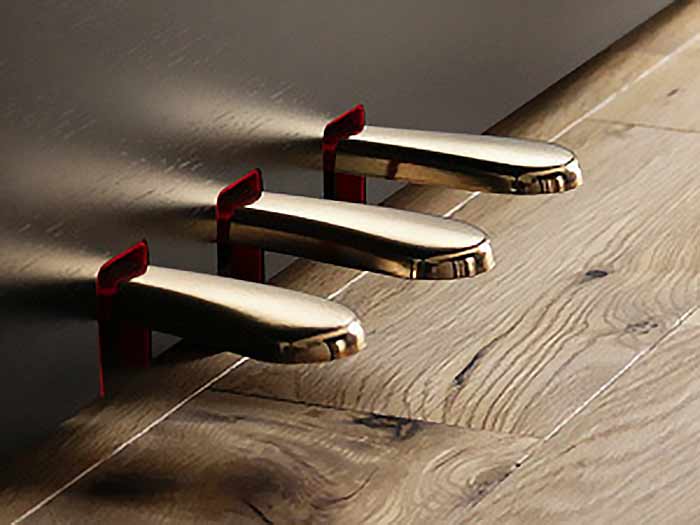Hello and thanks for joining us! If you’d like to read an in-depth review of the Kawai CA58 digital piano, you’ve come to the right place.
The Kawai CA58 essentially sits in the middle of the pack as far as Kawai’s Concert Artist series (CA series) is concerned, as it’s certainly a professional quality instrument built for serious institutional use, but it doesn’t have all of the latest technology like the top CA series instruments do.
So, for the purposes of this review, we’ll not only cover all of the relevant details of this instrument, but we’ll also identify who might be served from bypassing the CA48 and coming up to the CA58, without jumping ahead to the CA79.
Background
As mentioned above, the CA58 is the second entry in the Kawai CA series lineup, which starts with the CA48, and ends with the very advanced CA79 and CA99.
Despite being an instrument with a lot to offer, it seems as though the CA58 is sometimes a bit overlooked as it can get lost in the mushy middle, and perhaps doesn’t have as specific a value proposition as the CA48 or CA79 does.
While these concerns about value are probably true, the fact of the matter is, though, there are certain users out there for who the CA58 will be the perfect instrument.
For those users, the spec upgrades over the CA48, including a superior sound engine with more polyphony, a better speaker system, and discreet line outputs are well worth the extra cost.
With that out of the way, let’s take a closer look at the sound engine.
Piano Sound
The sound on the CA58 is produced by Kawai’s Harmonic Imaging XL engine (HI-XL). This is an upgraded, more complex sound engine than what you’ll find in the CA48, as well as the CN series.
It features 256 notes of maximum polyphony and is based on an 88-key stereo sample of the Shigeru Kawai SK-EX and Kawai EX concert grand pianos. It’s also a multidimensional sample set which means different microphones were placed throughout and around the piano, rather than just doing a basic left-right stereo image.
The result is an extremely detailed sound engine producing beautiful grand piano sound, and that’s coming at you through 100 watts of speaker power, which includes two tweeters on top, and two mains on the underside of the keyboard.
Something that sometimes throws people off is that the control panel on the left-hand side looks the same as the control panel featured on the CN39. Otherwise, it doesn’t really resemble any of the control panels throughout the rest of Kawai’s entire digital panel lineup, as it’s actually a remnant from a couple of generations ago.
The touch screen on the CA79 and 99 is much more advanced and modern, so this old version sticks out a little bit like a sore thumb.
That said, navigating the remaining patches (of which there are 42) and features of the instrument is extremely easy, as each sound category, such as piano, electric piano, or organ, is represented by its own button.
A quick note on the organ tones; pressing the left pedal on the CA58 triggers a rotary speaker effect, so this is a pretty great effect for use with organ tones.
You can tell that the CA series has a pretty big audience in the Worship community because of how much attention Kawai has put into their organs patches, which are exceptional.
Kawai has also incorporated their Spatial Headphone Sound feature, which improves the experience when playing with headphones plugged in.

The control panel also gives you access to Kawai’s Virtual Technician, which allows you to go in and edit all kinds of sound-related parameters, such as damper resonance, key volume, and minimum touch, as well as different effects settings like Reverb.
So, there you have it with regard to the sound system here. The Kawai CA58 is producing some great sound, with a higher fidelity engine than what you’re getting on the CA48, with more than double the speaker power too.
Action
Moving over to the keyboard action portion of our discussion, the CA58 is equipped with Kawai’s Grand Feel Compact Action. The Grand Feel Compact actually features a very similar design to the original Grand Feel action, which has been replaced by the longer key sticks of the Grand Feel II and Grand Feel III actions.

This is a wooden key action with let-off, triple sensor key detection, and bass region counterweights. Being a wood-based action, you’ll find that the dynamic behavior of the keys ends up skewing more towards that of a real acoustic piano action since those are obviously wood as well.
We also need to mention the ebony and ivory touch key surfaces. These textures provide a nice tactile sensation and grip for your fingers, while also absorbing moisture during more intense playing sessions.
All in all, we’re left with very good action, and the only real competitor from the action playing experience perspective at the price point is Roland’s wooden PHA4 action. Yamaha doesn’t really have a direct competitor model at the price point.
Since the CA48 also has the same action, if the extra upgrades on the CA58 don’t appeal to you, and you’re only really focused on action, the CA48 suddenly becomes a super compelling option instead.
Features & Connectivity
Let’s start with the connectivity. The Kawai CA58 is equipped with a Bluetooth MIDI connection, which allows you to remote control the piano via Kawai’s sound museum app.
You can also control the Virtual Technician app this way which adds a nice visual component, and you can connect to apps like GarageBand and Logic, as well as any sort of DAW software, which is Bluetooth MIDI compliant.

The Kawai CA58 also has quarter-inch outputs with independent output volume control, which is why it would be an ideal solution for folks who need a performance digital piano that can connect to an amp or PA system.
It also has a stereo mini-jack line in, dual headphone jacks, traditional MIDI In and Out, as well as USB Type-A and B.
In terms of features, standards like Layer, Split, and Four Hands mode are all covered, as is a fun Concert Magic feature. There are also some preloaded music books like Alfred and Czerny as well.
There’s also a built-in recorder that allows you to record, overdub, and playback WAV and SMF files.
The cabinet is built like a tank, which again, adds testament to the fact that this is built equally for the home and serious institutional use. It has a nice built-in key cover and is available in both Premium Rosewood and Satin Black finishes.
Something that will appeal to classical pianists is the presence of Kawai’s Grand Feel Pedal System. In addition to the damper (capable of half-pedal), sostenuto, and soft pedals, the spring tension of the pedals has also been matched to that of a typical acoustic grand piano.

Closing Thoughts
As we said at the start, while the CA58 may not scream value as strong as the CA48 or CA79, it certainly has a strong value proposition to the right buyer.
If you’re looking for a piano with a great sound engine, wooden action, and line outputs, so you can connect to an amp or PA system, the CA58 becomes an obvious choice over the CA48, and still costs a lot less than the CA79.
As we’ve said, in the sub $4,000 CAD price point, Kawai CA58 is probably one of the most compelling options for a music school, or especially a church, given the excellent organ sounds.


